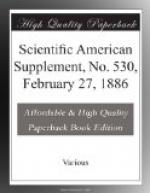Turning to the mechanical details, it is noticeable that no tools are required to take the weapon to pieces and to put it together. By removing a milled headed screw seen to the left of the general view, every individual part of the lock action comes apart, and can be cleaned and put together again in a few minutes. This screw is numbered 24 in Fig. 4. To load the pistol the thumb piece (marked 2 in Fig. 4 and shown separately in Fig. 3) is drawn back, and thus withdraws the sliding bolt, 3, from the barrel, 20. The barrel and cylinder are then tilted on the pin, 15—a shake will effect this if only one hand be available—and as the chamber rises, the extractor is forced back by the lifter, 15, and the empty shells are thrown out. When the barrel has moved about 80 deg., the spring, 14, which works the lifter, 15, is tripped, and the spring 13 carries the extractor home ready for the fresh cartridge to be inserted. When these are in place, the barrel and cylinder are returned to the position shown in Fig. 1, and are automatically locked by the bolt, 3. All is then ready for firing. The middle finger is placed on the cocking lever, and the forefinger within the trigger guard. The cocking trigger is drawn back, taking with it the firing trigger for the greater part of its stroke. At the same time the lifter, 8, which is pivoted to the cocking lever, engages with a ratchet wheel (seen in Fig. 2) attached to the cylinder, and rotates it through one-sixth of a revolution. To insure the exact amount of rotation, a heel on the trigger, not to be seen in the engravings, engages in one of the six slots (Figs. 1 and 2) formed round the barrel. The end of the slot is square, and comes up against the heel, which tightly grips the cylinder, and holds it steady while firing. A toe-piece, just over the figure 4, in Fig. 3, holds the cylinder when the cocking trigger is in its normal position. The cocking lever also compresses the main spring, 7, and holds it in this state until the firing trigger, 12, is pressed by the forefinger against the sear, 9, and the hammer, 5, is driven forward against the cartridge. If the pistol be not fired, the release of the cocking trigger takes the pressure off the spring, and there is thus no danger of accidental discharge.
It will thus be seen, says Engineering, that the weapon presents many advantages. It can be loaded on horseback when one hand is engaged with the reins; there is nothing to obstruct the aim, and the act of firing does not throw up the muzzle, for the two operations of cocking and shooting are separate, and consequently the latter needs only a very light pressure of the finger to effect it. The breech is well protected, so that the flash from a burst cartridge cannot reach the face of the user. The mechanism is as nearly dust proof as possible, and can be entirely taken to pieces and cleaned in a few moments, and the whole forms as handy a weapon as can be desired, where rapid and accurate shooting is required.




